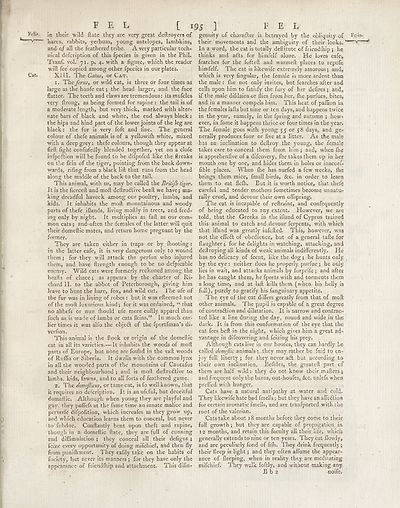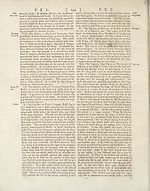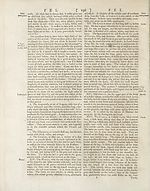Encyclopaedia Britannica > Volume 7, ETM-GOA
(215) Page 195
Download files
Complete book:
Individual page:
Thumbnail gallery: Grid view | List view

F E L [ 195 ] F E L
in their wild ftate they are very great deftroyers of
hares, rabbits, yerbuas, young antelopes, lanabkins,
and qf all the feathered tribe. A very particular tech¬
nical defcription of this fpecies is given in the Phil.
Tranf. voh 71. p. 4. with a figure, which the reader
will fee' copied among other fpecies in our plates.
XIII. The Catus, or Cat.
1. The fcrus, or wild cat, is three or four times as
large as the houfe cat; the head larger, and the face
flatter. The teeth and claws are tremendous: itsmufcles
very ftrong, as being formed for rapine : the tail is of
a moderate length, but very thick, marked with alter¬
nate bars of black and white, the end always black:
the hips and hind part of the lower joints of the leg are
black: the fur is very foft and fine. The general
colour of thefe animals is of a yellowifh white, mixed
with a deep grey: thefe colours, though they appear at
firft fight confufedly blended together, yet on a clofe
infpe6tion will be found to be difpofed like the ftreaks
on the (kin of the tiger, pointing from the back down¬
wards, rifing from a black lift that runs from the head
along the middle of the back to the tail.
This animal, with us, may be called the Briti/h tiger.
It is the fierceft and moft deftrudive beaft we have; ma¬
king dreadful havock among our poultry, lambs, and
kids. It inhabits the moft mountainous and woody
parts of thefe iflands, living moftly in trees, and feed¬
ing only by night. It multiplies as faft as our com¬
mon cats; and*often the females of the latter will quit
their domeftic mates, and return home pregnant by the
former.
They are taken either in traps or by (hooting:
in the latter cafe, it is very dangerous only to wound
them ; for they will attack the perfon who injured
them, and have ftrength enough to be no defpicable
enemy. Wild cats were formerly reckoned among the
beaft s of chace; as appears by the charter of Ri¬
chard II. to the abbot of Peterborough, giving him
leave to hunt the hare, fox, and wild cat. The ufe of
the fur was in lining of robes: but it was efteemed not
of the moft luxurious kind; for it was ordained, “ that
no abbefs or nun (hould ufe more coftly apparel than
fuch as is made of lambs or cats (kins.” In much ear¬
lier times it was alfo the objed of the fportfman’s di-
verfion.
This-animal is the ftock or origin of the domeftic
eat in all its varieties.—It inhabits the woods of moft
parts of Europe, but none are foubd in the vaft woods
of Ruffia or Siberia. It dwells with the.common lynx
in all the wooded parts of the mountains of Caucafus
and their neighbourhood ; and is moft deftrudive to
lambs, kids, fawns, and to all forts of feathered game.
2. The domejlicus, or tame cat, is fo wellknown, that
it requires no defcription. It is an ufeful, but deceitful
domettic. Although when young they are playful and
gay. they poffefs at the fame time an innate malice and
perverfe difpofition, which increafes as they grow up,
and which education learns them to conceal, but never
to' fuhdue. Conftantly bent upon theft and rapine,
though in a domeftic ftate, they are full of cunning
and diffimulation ; they conceal all their defigns ;
feize every opportunity of doing mifchief, and then fly
from puniftiment. They eafily take on the habits of
fociety, but never its manners ; for they have only the
appearance of friendftiip and attachment. This difin-
genuity of charader is betrayed by the obliquity of Fe:
their movements and the ambiguity of their looks. ^
In a word, the cat is totally deftitute of friendlhip ; he
thinks and ads for himfelf alone. He loves eafe,
fearches for the fofteft and warmeft places to repofe
himfelf. The cat is likewife extremely amorous; and,
which is very Angular, the female is more ardent than
the male: (he not only invites, but fearches after and
calls upon him to fatisfy the fury of her defires ; and,
if the male difdains or fiies from her, (lie purfues, bites,
and in a manner compels him. This heat of paflion ia
the females lafts but nine or ten days, and happens twice
in the year, namely, in the fpring and autumn ; how¬
ever, in fame it happens thrice or four times in the year.
The female goes with youfig 55 or 58 days, and ge¬
nerally produces four or five at a litter. As the male
has an inclination to deftroy the young, the female
takes care to conceal them from him; and, when (he
is apprehenfive of a difcovery, (he takes them up in her
mouth one by one, and hides them in holes or inaccef-
fible places. When (he has nurfed a few weeks, (he
brings them mice, fmall birds, &c. in order to learn
them to eat fle(h. But it is worth notice, that thefe
careful and tender mothers fometimes become unnatu¬
rally cruel, and devour their own offspring.
Xhe cat is incapable of reftraint, and confequently
of being educated to any extent. However, we are
told, that the Greeks in the ifland of Cyprus trained
this animal to catch and devour ferpents, with which
that ifland was greatly infefted. This, however, was
not the effe& of obedience, but of a general tafte for
(laughter; for he delights in watching, attacking, and
deftroying all kinds of weak animals indifferently. He
has no delicacy of fcent, like the dog; he hunts only
by the eye : neither does he properly purfue ; he only
lies in wait, and attacks animals by furprife ; and after
he has caught them, he fports with and torments them
along time, and at laft kills.them (when his belly is
full), purely to gratify his fanguinary appetite.
The eye of the cat differs greatly from that of moft
other animals. The pupil is capable of a great degree
of contra&ion and dilatation. It is narrow and contrac¬
ted like a line during the day, round and wide in the
dark. It is from this conformation of the eye that the
cat fees heft in the night, which gives him a great ad¬
vantage in difcoyering and feizing his prey.
Although cats live in our houfes, they can hardly be
called domejiic animals; they may rather be faid to en¬
joy full liberty ; for they never aft but according to
their own inclination. Befides, the greateft part of
them are half wild : they do not know their mafters ;
and frequent only the barns, out-houfes, &c. unlefs when
preffed with hunger.
Cats have a natural antipathy at water and cold.
They likewife hate bad fmells; but they have an affeftioa
for certain aromatic fmells, and are tranfported with the
root of the valerian.
Cats take about 18 months before they come to their
full growth; but they are capable of propagation in
12 months, and retain this faculty all their life, which
generally extends to nine or ten years. They eat (lowly,
and are peculiarly fond of fifli. They drink frequently;
their deep is light; and they often affume the appear¬
ance of deeping, when in reality they are meditating
mifchief. They walk foftly, and without making any
B b z noife.
in their wild ftate they are very great deftroyers of
hares, rabbits, yerbuas, young antelopes, lanabkins,
and qf all the feathered tribe. A very particular tech¬
nical defcription of this fpecies is given in the Phil.
Tranf. voh 71. p. 4. with a figure, which the reader
will fee' copied among other fpecies in our plates.
XIII. The Catus, or Cat.
1. The fcrus, or wild cat, is three or four times as
large as the houfe cat; the head larger, and the face
flatter. The teeth and claws are tremendous: itsmufcles
very ftrong, as being formed for rapine : the tail is of
a moderate length, but very thick, marked with alter¬
nate bars of black and white, the end always black:
the hips and hind part of the lower joints of the leg are
black: the fur is very foft and fine. The general
colour of thefe animals is of a yellowifh white, mixed
with a deep grey: thefe colours, though they appear at
firft fight confufedly blended together, yet on a clofe
infpe6tion will be found to be difpofed like the ftreaks
on the (kin of the tiger, pointing from the back down¬
wards, rifing from a black lift that runs from the head
along the middle of the back to the tail.
This animal, with us, may be called the Briti/h tiger.
It is the fierceft and moft deftrudive beaft we have; ma¬
king dreadful havock among our poultry, lambs, and
kids. It inhabits the moft mountainous and woody
parts of thefe iflands, living moftly in trees, and feed¬
ing only by night. It multiplies as faft as our com¬
mon cats; and*often the females of the latter will quit
their domeftic mates, and return home pregnant by the
former.
They are taken either in traps or by (hooting:
in the latter cafe, it is very dangerous only to wound
them ; for they will attack the perfon who injured
them, and have ftrength enough to be no defpicable
enemy. Wild cats were formerly reckoned among the
beaft s of chace; as appears by the charter of Ri¬
chard II. to the abbot of Peterborough, giving him
leave to hunt the hare, fox, and wild cat. The ufe of
the fur was in lining of robes: but it was efteemed not
of the moft luxurious kind; for it was ordained, “ that
no abbefs or nun (hould ufe more coftly apparel than
fuch as is made of lambs or cats (kins.” In much ear¬
lier times it was alfo the objed of the fportfman’s di-
verfion.
This-animal is the ftock or origin of the domeftic
eat in all its varieties.—It inhabits the woods of moft
parts of Europe, but none are foubd in the vaft woods
of Ruffia or Siberia. It dwells with the.common lynx
in all the wooded parts of the mountains of Caucafus
and their neighbourhood ; and is moft deftrudive to
lambs, kids, fawns, and to all forts of feathered game.
2. The domejlicus, or tame cat, is fo wellknown, that
it requires no defcription. It is an ufeful, but deceitful
domettic. Although when young they are playful and
gay. they poffefs at the fame time an innate malice and
perverfe difpofition, which increafes as they grow up,
and which education learns them to conceal, but never
to' fuhdue. Conftantly bent upon theft and rapine,
though in a domeftic ftate, they are full of cunning
and diffimulation ; they conceal all their defigns ;
feize every opportunity of doing mifchief, and then fly
from puniftiment. They eafily take on the habits of
fociety, but never its manners ; for they have only the
appearance of friendftiip and attachment. This difin-
genuity of charader is betrayed by the obliquity of Fe:
their movements and the ambiguity of their looks. ^
In a word, the cat is totally deftitute of friendlhip ; he
thinks and ads for himfelf alone. He loves eafe,
fearches for the fofteft and warmeft places to repofe
himfelf. The cat is likewife extremely amorous; and,
which is very Angular, the female is more ardent than
the male: (he not only invites, but fearches after and
calls upon him to fatisfy the fury of her defires ; and,
if the male difdains or fiies from her, (lie purfues, bites,
and in a manner compels him. This heat of paflion ia
the females lafts but nine or ten days, and happens twice
in the year, namely, in the fpring and autumn ; how¬
ever, in fame it happens thrice or four times in the year.
The female goes with youfig 55 or 58 days, and ge¬
nerally produces four or five at a litter. As the male
has an inclination to deftroy the young, the female
takes care to conceal them from him; and, when (he
is apprehenfive of a difcovery, (he takes them up in her
mouth one by one, and hides them in holes or inaccef-
fible places. When (he has nurfed a few weeks, (he
brings them mice, fmall birds, &c. in order to learn
them to eat fle(h. But it is worth notice, that thefe
careful and tender mothers fometimes become unnatu¬
rally cruel, and devour their own offspring.
Xhe cat is incapable of reftraint, and confequently
of being educated to any extent. However, we are
told, that the Greeks in the ifland of Cyprus trained
this animal to catch and devour ferpents, with which
that ifland was greatly infefted. This, however, was
not the effe& of obedience, but of a general tafte for
(laughter; for he delights in watching, attacking, and
deftroying all kinds of weak animals indifferently. He
has no delicacy of fcent, like the dog; he hunts only
by the eye : neither does he properly purfue ; he only
lies in wait, and attacks animals by furprife ; and after
he has caught them, he fports with and torments them
along time, and at laft kills.them (when his belly is
full), purely to gratify his fanguinary appetite.
The eye of the cat differs greatly from that of moft
other animals. The pupil is capable of a great degree
of contra&ion and dilatation. It is narrow and contrac¬
ted like a line during the day, round and wide in the
dark. It is from this conformation of the eye that the
cat fees heft in the night, which gives him a great ad¬
vantage in difcoyering and feizing his prey.
Although cats live in our houfes, they can hardly be
called domejiic animals; they may rather be faid to en¬
joy full liberty ; for they never aft but according to
their own inclination. Befides, the greateft part of
them are half wild : they do not know their mafters ;
and frequent only the barns, out-houfes, &c. unlefs when
preffed with hunger.
Cats have a natural antipathy at water and cold.
They likewife hate bad fmells; but they have an affeftioa
for certain aromatic fmells, and are tranfported with the
root of the valerian.
Cats take about 18 months before they come to their
full growth; but they are capable of propagation in
12 months, and retain this faculty all their life, which
generally extends to nine or ten years. They eat (lowly,
and are peculiarly fond of fifli. They drink frequently;
their deep is light; and they often affume the appear¬
ance of deeping, when in reality they are meditating
mifchief. They walk foftly, and without making any
B b z noife.
Set display mode to:
![]() Universal Viewer |
Universal Viewer | ![]() Mirador |
Large image | Transcription
Mirador |
Large image | Transcription
Images and transcriptions on this page, including medium image downloads, may be used under the Creative Commons Attribution 4.0 International Licence unless otherwise stated. ![]()
| Encyclopaedia Britannica > Encyclopaedia Britannica > Volume 7, ETM-GOA > (215) Page 195 |
|---|
| Permanent URL | https://digital.nls.uk/189124024 |
|---|
| Attribution and copyright: |
|
|---|
| Description | Ten editions of 'Encyclopaedia Britannica', issued from 1768-1903, in 231 volumes. Originally issued in 100 weekly parts (3 volumes) between 1768 and 1771 by publishers: Colin Macfarquhar and Andrew Bell (Edinburgh); editor: William Smellie: engraver: Andrew Bell. Expanded editions in the 19th century featured more volumes and contributions from leading experts in their fields. Managed and published in Edinburgh up to the 9th edition (25 volumes, from 1875-1889); the 10th edition (1902-1903) re-issued the 9th edition, with 11 supplementary volumes. |
|---|---|
| Additional NLS resources: |
|

